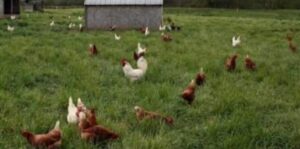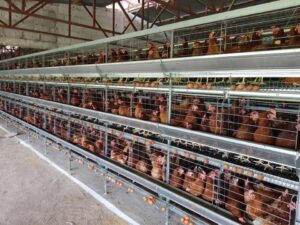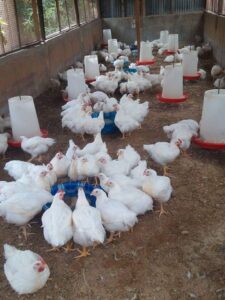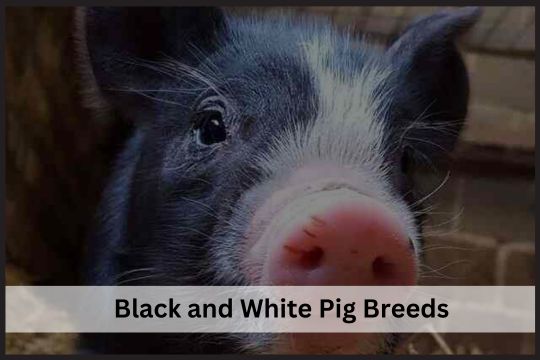Poultry farming is one of the most preferred farm business all around the globe. Millions of people are doing it at commercial level. Some are keeping poultry at household level. Whatever the scale, One thing is common i.e Housing System Of Poultry. There are some scientific methods of making the home for poultry. Housing refers to keeping the farm animals and poultry birds under a structure where they are safeguarded and comforted from troubles (Physical, Psychological or Physiological) and the owner can organize the routine work most effectively for optimum return.
Here, In this article, We will be learning about the Housing System Of Poultry in detail along with the advantages and disadvantages of each type of system.
Let’s the learning begin…
Housing System Of Poultry
There are four types of housing system popular among Poultry raisers. These type of housing system depends on amount of capital and land area availability. They types are:-
✓Free range or Extensive Housing System
✓Semi-intensive Housing System
✓Folding Housing System
✓Intensive Housing System
1.Free range/Extensive System

In this housing system of poultry, Unlimited space is provided to the Poultry birds on land where they can find an appreciable amount of food in forms of herbage, seeds and insects.
Advantages
➡️Rearing Cost Is Low.
➡️Expansion Of Housing Isn’t Required.
➡️Birds Search Their Food Requirement From Surrounding. So, Feeding Cost Is Low.
Disadvantages
➡️Loss Of Egg May Be A Big Problem, Hens Lay Eggs Everywhere.
➡️ Predatory Animals Causes Loss Of Poultry Birds.
➡️Infections Diseases And Parasites Problem May Occur.
2.Semi-intensive Housing System
In this poultry housing system, there is limited free space available for the poultry birds. It is necessary to provide 20-30 sq.m. outside run.
Advantages
➡️The Birds Can Move Onto The Fresh Ground.
➡️ Protection Against The Predatory Animals Is Possible.
Disadvantages
➡️The Run May Get Infected With The Droppings.
➡️The Birds May Be Infected With Infectious Diseases.
3.Folding Housing System
In this housing system of poultry, birds are confined to one small run, the position is changed each day, giving them fresh ground and the bird can find a considerable proportion of food from the herbage making them healthier and harder.
A floor space of 1 Sq.Ft. should be allowed to each bird in the house, and 3 Sq.Ft in the run, So – the total floor space of whole unit is 4.0 Sq.Ft/bird. The most convenient folding unit to handle is that which is made for 25 birds.
Advantages
➡️ Spreading Of Disease Is Less, As The Birds Are Confined To Small Run.
➡️No Fear Of Predatory Animals.
➡️ Scratching And Manuring On The Ground Is Beneficial For Farmers
Disadvantages
➡️Labor Cost Is High
➡️ Feeding, Watering And The Collection Of Eggs Need More Labour.
4.Intensive Housing System
In this housing system of poultry, the birds are confined to house entirely, with no access to land outside and it is usually adopted where land is limited and expensive. There are two types of Intensive poultry housing system which are explained below:-
A.Battery/Cage Rearing System

This is the most intensive system of poultry production and it is useful to those with only a small quantity of floor space at their disposal. In this system, Poultry are confined to a cage just large enough to permit to very limited movement and allow them to sit and stand comfortably.
Floor space of 14*16 inches and height of 17 inches is provided. The floor is of strongly galvanized iron wire set at a slope from back to front, so that the eggs as they laid, roll out of the cage to a receiving gutter. Underneath is a tray for droppings. Both water and food are outside the cage, many small can be assembled together, if necessary it may be multistoried.
Advantages
➡️Allows Better Flock Supervision.
➡️The Performance Of Each Bird Can Be Noted And Culling Is Easily Carried As When Needed.
➡️ Infertile Eggs Are Produced. These Eggs Can Be Preserved For Long Time Than Fertilized Eggs At Ordinary Temperature.
➡️Clean And Uniform Egg Production Throughout The Year Is Possible.
➡️Offers Economy In Space, Reduce Feed Consumption And Labor.
➡️Helps In Prevention And Control Of Certain Diseases Like Coccidiosis, Increase Efficiency Of Production.
Disadvantages
➡️Cage Fatigue Is One Of The Major Problem.
➡️ Malnutrition May Be The Problem.
➡️Egg Production By Hen Can Never Be Used For Hatching.
➡️ Feeding/Watering Requires More Labor.
➡️ Housing And Equipment Cost Is High.
B.Deep Litter System

In this housing system of poultry, birds are kept in large pens on the floor covered with the litters like straw, saw dust, dry leaves, rice husk etc. up to 8-12 inch. It can be defined as the accumulation of the organic materials used for litter with poultry manure until it reaches the depth of 8-12 inches.
This is also followed housing system of poultry in USA. In this system, Birds are kept loose in a building where they are free to roam around.
Optimum temperature can be maintained either by increasing the thickness winter or reducing the thickness in summer.
Advantages
➡️It Provides Safety To The Birds
➡️ Built Up Litter Also Supplies Some Food Nutrients To The Birds. They Obtain Animal Protein Factor From Deep Litter. Animal Protein Is Needed For Good Hatchability And Early Growth Of Chicks.
➡️It Provides Protection Against Various Infection Diseases And Parasites.
➡️Labor Saving Is One Of The Major Feature Of Deep Litter. Less Labor Is Required For Collecting And Handling Of Eggs.
➡️ Valuable Fertilizer: The Level Of Nitrogen In Fresh Manure Is About 1% But On Well Built Up Litter, It May Be Around 3% Nitrogen ( Nearly 20% Protein), 2% Phosphorus and 2 % Potash And Its Value Is About 3 Times That Of Cattle Manure.
➡️Hot Weather Safeguarded: The Litter Maintains Its Own Constant Temperature. Birds Can Warm Themselves, Self Control To Birds During Extreme Weather Condition.
Precautions In Deep Litter System
In every Housing System Of Poultry, we need to follow some precautions in order to prevent difficulties and production loss in future.
1. The floor of the house should be 45-60 cm high from the ground level. Concrete floor is preferable.
2. The birds should provided floor space 2- 2.5 sq. ft. per bird in case of layers and 1 sq. ft. in case of broiler.
3. The floor should not be damped.
4. The house should be well ventilated. The house should be south facing as it aid well ventilation.
5. The litter materials should be used in sufficient quantity to give a depth of 6-8 inches (15-21 cm). This is reduced to 5 —6 inches (12.5-15 cm) during summer. The litter should always be kept dry.
6. The poultry house equipment such as feeder, waterer, roost, nest box, shell and grit container, etc. should be arranged in specific place of the house. The waterer must be placed near the drainage channel.
7. The poultry house should have door of 6′ x 3′ size for easy accessible.
8. The poultry birds should be provided food having vitamin A and D as they do not synthesize vit. D for want of sunlight due to their confinement in the house.
Management Of Deep Litter Housing System Of Poultry
1.The floor of the house should disinfected by phenyl, Lysol, bleaching powder or lime water before placing litter materials.
2.The depth of litter should be 6 inch in summer and 8 inch in winter.
2.The deep litter should be kept dry. Wet litter in early stages of growth leads to the sporulation of coccidia. Lime or super phosphate L 500 gm lime or 1 kg. Superphosphate per square feet is applied to make the litter dry.
3.Cracking of litter should avoided as far as possible by keeping the humidity low and stirring of litter at least once in a week.
4.Fresh litter should be used for rearing pullets and new batches of birds should be placed in clean litter. The time of starting deep litter should be in the dry period of the year.
5.The old, built up litter should be replaced after the rainy season and beginning of winter season. The litter maybe kept for one year only.
6.The waterer should be placed in such a way to keep the litter dry. Leaking of water from waterer or roof, upsets the whole process and it would have to start over again.
Final Verdict
Thus, These are the 4 different types of housing system of poultry. They have their own benefits and demerits. Many people in America use all these methods.
So, This is whole information on, Housing System Of Poultry: Advantages And Disadvantages. If you have any confusion, Ask In Comments.
You May Like These Articles:-
Casting Of Animals: Cattle and Buffalo Casting


Thanks for right informantion about all agriculture and allied .
Please update me on mail if there is any study material uploaded by ,
:- beloved #Agriculture Guide
your
jr7